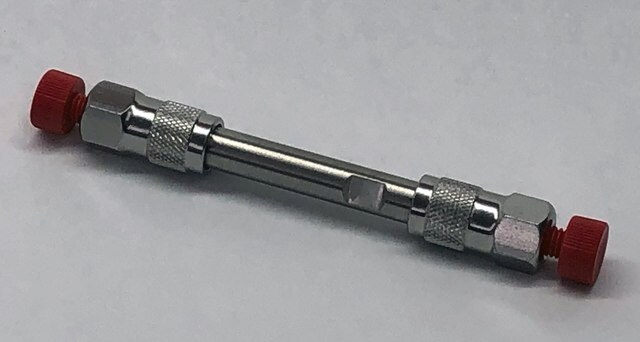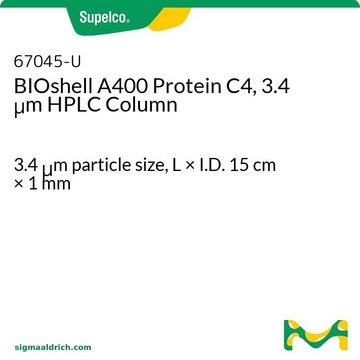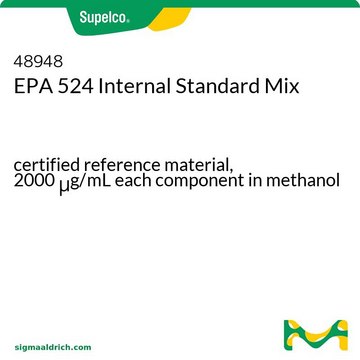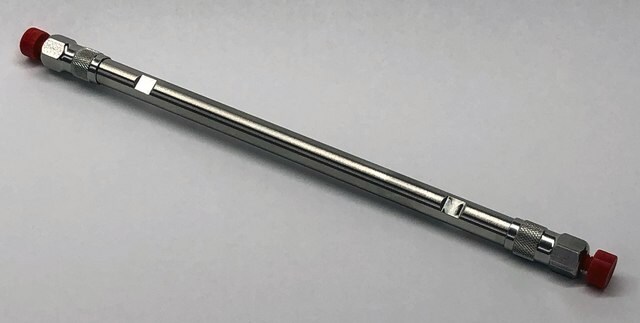50994-U
BIOshell Glycan (2.7 μm) HPLC Columns
L × I.D. 15 cm × 2.1 mm, HPLC Column
About This Item
Produits recommandés
product name
BIOshell Glycan HPLC Columns, L × I.D. 15 cm × 2.1 mm, 2.7 μm particle size
Matériaux
stainless steel hardware (column)
Niveau de qualité
Agence
suitable for USP L86
Description
shell thickness (0.5 μm)
solid core (1.7 μm)
Gamme de produits
BIOshell
Caractéristiques
endcapped: no
Classe(s) chimique(s) de l'analyte
glycans
Fabricant/nom de marque
BIOshell
Conditionnement
1 ea of
Paramètres
1000 bar max. pressure (14500 psi)
1000 bar pressure (14500 psi)
60 °C max. temp.
Technique(s)
HPLC: suitable
LC/MS: suitable
UHPLC-MS: suitable
UHPLC: suitable
L × D.I.
15 cm × 2.1 mm
Superficie
135 m2/g
Matrice
spherical silica particle platform
superficially porous particle
Groupe de la matrice active
hydroxy, penta- phase
Taille des particules
2.7 μm
Dimension de pores
90 Å
operating pH range
2-9
Technique de séparation
hydrophilic interaction (HILIC)
Vous recherchez des produits similaires ? Visite Guide de comparaison des produits
Description générale
View the BIOshell Glycan HPLC Columns Flyer
Application
Caractéristiques et avantages
Informations légales
Vous ne trouvez pas le bon produit ?
Essayez notre Outil de sélection de produits.
Produit(s) apparenté(s)
Faites votre choix parmi les versions les plus récentes :
Certificats d'analyse (COA)
Vous ne trouvez pas la bonne version ?
Si vous avez besoin d'une version particulière, vous pouvez rechercher un certificat spécifique par le numéro de lot.
Déjà en possession de ce produit ?
Retrouvez la documentation relative aux produits que vous avez récemment achetés dans la Bibliothèque de documents.
Articles
The BIOshell™ Glycan column is ideal for the separation and quantitation of isolated glycans using the HILIC method for accurate glycoprotein analysis.
The use of PNGase Fast denaturing buffer and enzyme yielded results similar to a conventional 20-hour protocol with overnight digest while reducing workflow time to about 1 hour with a 15-minute digest.
Step-by-step workflows for the intact mass analysis, peptide mapping, and N-glycan analysis of the monoclonal antibody― adalimumab, for an accurate characterization of the critical quality attributes (CQAs) to ensure drug safety and efficacy. Read more.
Protocoles
Separation of Dextran Ladder, Glycan standard for HPLC
A step-by-step protocol for released N-linked glycan analysis of the monoclonal antibody adalimumab, based on UHPLC-FLR-MS and procainamide labeling.
Contenu apparenté
HPLC separates and identifies large biomolecules like proteins and peptides by pumping the sample through a sorbent-packed column.
La chromatographie liquide haute performance (HPLC) peut être utilisée pour séparer et identifier différentes biomolécules de grande taille, telles que les protéines et les peptides, d'un échantillon. Cette technique consiste à pomper, sous haute pression, un échantillon avec un solvant (phase mobile) au travers d'une colonne remplie d'un matériau sorbant (phase stationnaire).
Notre équipe de scientifiques dispose d'une expérience dans tous les secteurs de la recherche, notamment en sciences de la vie, science des matériaux, synthèse chimique, chromatographie, analyse et dans de nombreux autres domaines..
Contacter notre Service technique








